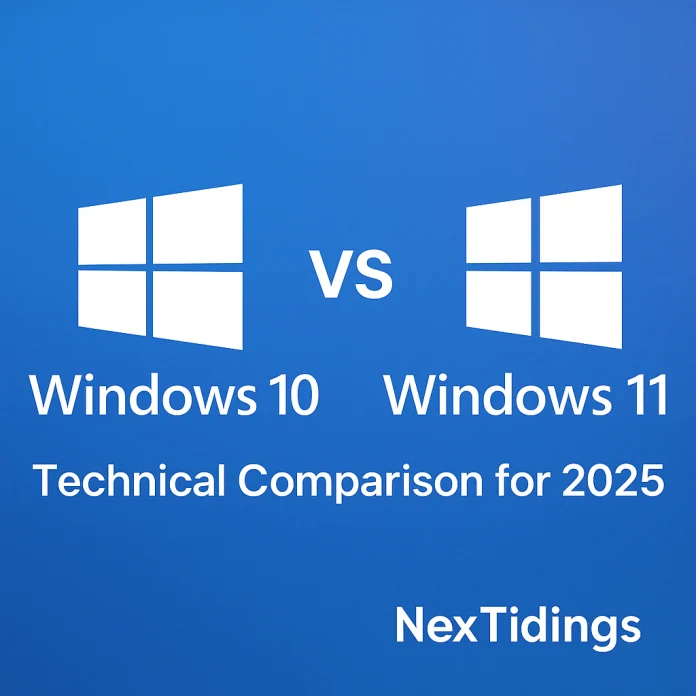Introduction
As technology continues to advance, the operating systems powering our devices must evolve to meet new demands. Microsoft’s Windows 10, released in 2015, was widely praised for its stability, versatility, and compatibility. However, with the release of Windows 11 in late 2021, users and businesses began reassessing whether Windows 10 remained the right choice moving forward.
This article provides a comprehensive technical comparison between Windows 10 and Windows 11, analyzing core aspects such as UI design, performance, security, system requirements, gaming features, and software compatibility to help you decide whether to upgrade or stick with your current OS.
UI Design
Visual Aesthetics
Windows 11 introduces a modernized and polished visual interface, departing from the more utilitarian look of Windows 10. Key changes include:
- Rounded window corners
- A centered taskbar
- New icons and animations
- Enhanced dark and light modes
The new design emphasizes simplicity and coherence, aligning with modern UI/UX standards. Windows 10, while functional, now appears dated in comparison.
Start Menu and Taskbar
The Live Tiles in Windows 10’s Start Menu have been removed in Windows 11. Instead, the Start Menu features:
- A centered layout
- Pinned apps in a grid
- A “Recommended” section based on recent activity
The taskbar is also centered by default, though users can adjust it. Windows 11 also includes widget support for quick access to calendar, weather, and news feeds.
Performance Optimization
Speed and Efficiency
Windows 11 is designed to be faster and more efficient:
- Improved memory management
- Reduced CPU usage for background apps
- Faster resume from sleep
- Optimized performance for foreground tasks
Benchmark tests suggest that Windows 11 boots faster and provides smoother multitasking on compatible hardware compared to Windows 10.
Resource Management
Windows 11 introduces smart resource allocation. Features like Dynamic Refresh Rate and better handling of background services lead to enhanced battery life and system efficiency—especially on laptops.
DirectStorage Support
Exclusive to Windows 11, DirectStorage allows games and applications to load assets directly from SSD to GPU, reducing latency and loading times. It represents a significant leap in I/O performance, especially for gamers.
Security Enhancements
Hardware-Based Security
One of the most notable shifts in Windows 11 is its hardware-level security:
- TPM 2.0 is required for installation
- Secure Boot ensures OS integrity
- Virtualization-based security (VBS) and Memory Integrity are enabled by default
These measures provide enhanced protection against firmware and kernel-level attacks.
Windows Hello and Authentication
Windows Hello continues to evolve in Windows 11, offering faster facial recognition and fingerprint authentication. It’s tightly integrated with hardware, allowing for passwordless sign-ins.
Windows Defender + ATP
The built-in Windows Security suite has been strengthened with:
- Real-time malware scanning
- Cloud-delivered protection
- Advanced Threat Protection (ATP) for proactive threat detection
Windows 11 is a security-first OS, ideal for enterprise and privacy-conscious users.
System Requirements
Minimum Specs
| Component | Windows 10 | Windows 11 |
|---|---|---|
| CPU | 1 GHz, 1 core | 1 GHz, 2 cores, 64-bit |
| RAM | 1 GB / 2 GB | 4 GB |
| Storage | 16 / 20 GB | 64 GB |
| TPM | Not required | TPM 2.0 required |
| Secure Boot | Optional | Required |
Compatibility Tools
Microsoft offers a PC Health Check Tool to verify eligibility. Devices that don’t meet the requirements can still run Windows 10 until support ends in October 2025.
Gaming Features
DirectX 12 Ultimate & Auto HDR
Windows 11 supports DirectX 12 Ultimate, delivering advanced graphical features like ray tracing, variable rate shading, and mesh shaders.
Auto HDR enhances visual fidelity in supported games, making colors more vivid and scenes more dynamic.
Xbox Integration
With built-in Xbox Game Pass support, Windows 11 allows users to stream or download titles from a vast library. Features like Xbox Cloud Gaming and cross-platform play enrich the gaming ecosystem.
Software Compatibility
Legacy Application Support
Windows 11 retains strong backward compatibility, running most software built for Windows 10 and even older platforms. However, some legacy 32-bit apps or older hardware drivers may face issues.
Microsoft Store Improvements
The revamped Microsoft Store in Windows 11 offers:
- A more curated user experience
- Support for Win32, UWP, and Android apps
- Better app discovery and developer incentives
Developer & Virtualization Tools
Developers benefit from:
- Windows Subsystem for Linux (WSL)
- Enhanced Hyper-V for virtualization
- Support for containers and DevOps workflows
These upgrades make Windows 11 especially appealing for software engineers and IT professionals.
Conclusion
Windows 11 brings a refreshed experience with a visually modern interface, improved performance, enhanced security, and robust support for gaming and productivity. However, it demands newer hardware and may require users to adapt to a slightly different workflow.
If your device is eligible and you’re seeking better performance and future-proof features, upgrading to Windows 11 is a smart move. Otherwise, Windows 10 remains a reliable option until its support ends in October 2025.
FAQs
1. Can I upgrade to Windows 11 for free if I have Windows 10?
Yes, if your device meets the minimum requirements, the upgrade is free.
2. What are the minimum system requirements for Windows 11?
You need a 64-bit CPU with 2 or more cores, 4 GB of RAM, 64 GB storage, TPM 2.0, and Secure Boot support.
3. Will my old software work on Windows 11?
Most Windows 10 apps are compatible, but check mission-critical apps before upgrading.
4. Does Windows 11 require a Microsoft account?
Yes, the Home edition does. The Pro edition allows for local accounts during setup.
5. Is Windows 11 better for gaming?
Yes. Features like DirectStorage, Auto HDR, and DirectX 12 Ultimate enhance gaming performance significantly.

